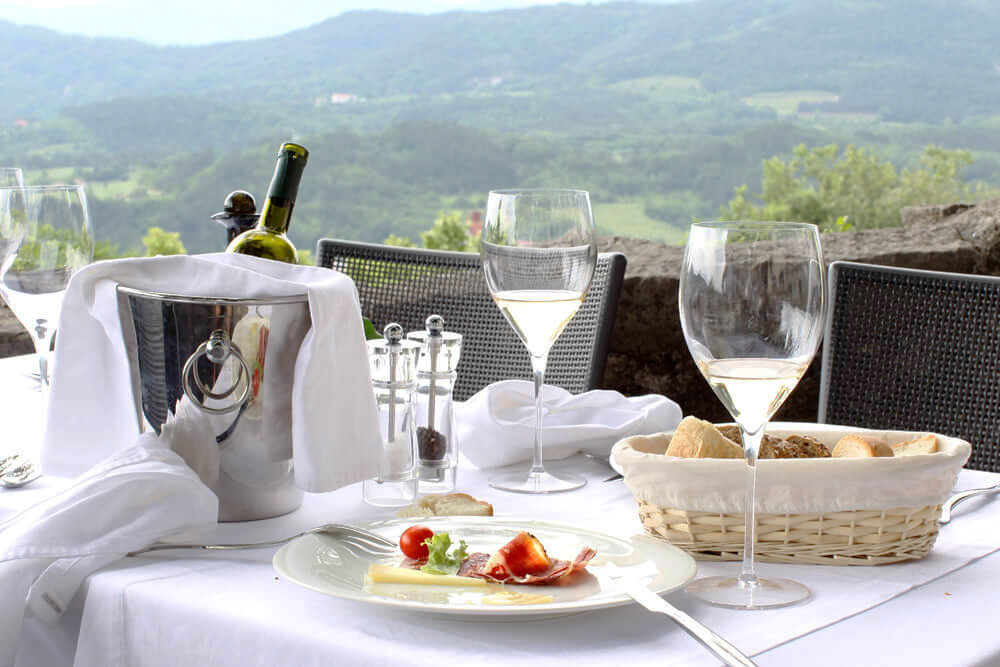Natural Habitat Adventures’ tour of Croatia and Slovenia offers an intimate encounter with nature while exploring the cultural heritage and culinary highlights of these two Balkan countries. Dine on locally sourced gourmet fare at Michelin-star restaurants and boutique hotels overlooking the sea. Visit romantic wineries and traditional farms continuing sustainable production of olive oil, honey and cheese. Below are a sampling of the seasonal ingredients and regional specialties found from the Adriatic Coast to the Eastern Alps.

Olive Oil
Olive oil—the most important staple in any Mediterranean kitchen. Family lineages have produced olive oil throughout the centuries on the Dalmatian Islands. In a small fishing village on the island of Kornat, enjoy an authentic Dalmatian menu infused throughout with fresh-pressed olive oil. Snack on fried olives with herbs and cheese and clink glasses under the shade of ancient olive groves before sailing back to the mainland.
Legend says that Julius Caesar’s favorite olive oil came from Istria, and the peninsula takes pride in producing the finest oils—the famed guide Flos Olei went so far as to declare Istria the best region for olive oil in the world. While you’re there, savor olive oil drizzled on potatoes and garlic and dipped in homemade bread baked in wood-burning ovens.

Truffles
Istrian truffles are renowned: one of the largest white truffles in the world was found here by Giancarlo Zigante, weighing 2.8 pounds—it’s no wonder the Motovun woods are known as “the land of truffles.” Surrounded by castles and ancient churches, we’ll head into the forest with a family of third-generation truffle hunters. Friendly dogs help us find these coveted culinary treasures, and we’ll taste these delicacies in different products. Be sure to try Croatian fuži, a homemade pasta with shaved black truffle and cream.

Artisan Cheese
On the white limestone island of Pag, aromatic hard cheeses are made from sheep’s milk. As sea winds blow, a salty spray falls upon the fragrant purple-flowered sage sheep graze on, imbuing their milk with flavor. Along with cheese, Pag Island produces some of the oldest and finest sea salt in Europe, with salt pans dating back to the 10th century.
In the Eastern Alps, milk cows graze in alpine meadows. On the lush slopes of the sparkling Lake Bohini, we’ll sample artisan cheeses in a village that has been making cheese since the 13th century. During your travels, you’ll delight in creamy cheeses baked into galettes (prisnac), phyllo rolls (strukli) and flaky pastries (börek).

Honey
Slovenia is considered the heart and soul of beekeeping in Europe, and you’ll have an insider’s look at honey harvesting during a visit to a 90-year-old apiary. You’ll have a chance to try honey in different forms, including pollen, liqueur, homemade gingerbread and nutty loaves of potica.
There are many other Balkan desserts using honey, such as Dalmatian fresh fig tarts, walnut rolls (orahnjača), Croatian honey cookies (medenjaci) and bundt cakes (kugelhopf). Besides honey, jam from native plums, apricots and rosehips are incorporated into Slovenian strudels, Croatian doughnuts, crepes, cakes, croissants and dumplings.

Seafood
As you sit down for a candlelit dinner overlooking the coast, fresh seafood simmers in a pot with tender vegetables over an open fireplace. Michelin-star restaurants serve this well-loved dish, gregada, along with Adriatic tuna carpaccio, sea bass risotto and lobster. You’ll dine on roasted and grilled fish with extra virgin olive oil, buttery prawns cooked in wine and oysters harvested from beds since the time of the Roman Empire. Along the Opatija Riviera, you’ll take a seaside promenade to the fishing village of Volosko for an evening meal featuring the catch of the day. You may even have a chance to try Bakalar, a traditional Christmas stew of salted cod.

Vegetables and Herbs
With an abundance of sun and rich soils, Croatia’s agricultural regions offer travelers a plethora of vegetables, including delicate wild asparagus, kale, radicchio, fennel, zucchini, chard, eggplant and peas. Vegetable-forward dishes range from stuffed cabbage rolls (sarma) to smoky vegetable soup with spring corn (maneštra). Cuisine along the coast is rich with Greek and Roman influences, with herbal and citrus notes of oregano, orange rind, lemon, marjoram, sage, bay and summer savory.

Wine
On visits to lush vineyards, you’ll observe the art of ancient winemaking. Be sure to try the white wine Malvasia, queen of Istrian wine cellars, and the acclaimed ruby red Dingač. In addition, you’ll enjoy aperitifs of herbal liquors and plum, grape and pear brandies.
Dining in Croatia and Slovenia delights all senses, from the aroma of honey pastries to the taste of truffles. Soak in the Mediterranean scenery and elegant ambiance as you feast under gnarled olive trees backdropped by the crystal waters of the Adriatic Sea. Join Natural Habitat Adventures on a tour that highlights the best gastronomic experiences these two diverse countries have to offer.

























